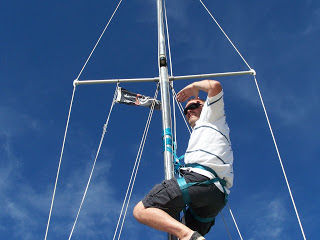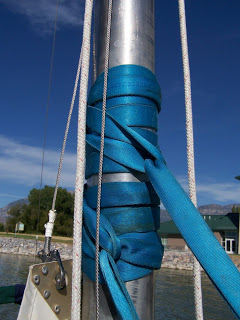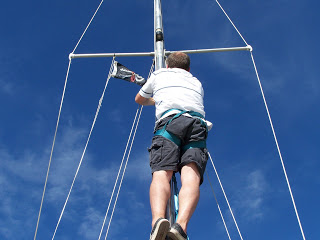 My brother Dan and I decided to get up early and get a couple hours of sailing in before things got too busy. We arrived at the marina around 7am (ok, not too early after all.)
My brother Dan and I decided to get up early and get a couple hours of sailing in before things got too busy. We arrived at the marina around 7am (ok, not too early after all.)
We had a great light air sail using the main, genoa, and whisker pole. It was one of those sails where you just sit back and relax, talking about pointless, useless, interesting things. (Our discussion centered around how we could design a time capsule that could be buried in the lake, and then found and retrieved years later – yeah, it was that relaxing.)
On the way back to the marina we encountered a problem. The foresail halyard managed to get wedged into the top of the rear shroud’s cotter pin. No matter what we tried, it would not come free. I was not anxious to lower the mast, so we applied some climbing and caving skills we had to develop a simple mast climbing system.
 In caving, there is frequently a need to ascend ropes, and there are fairly elaborate harness systems which make that possible. The challenge in this case was that we needed some way to grip the mast for climbing.
In caving, there is frequently a need to ascend ropes, and there are fairly elaborate harness systems which make that possible. The challenge in this case was that we needed some way to grip the mast for climbing.
I suggested the Prusik know (named for its inventor, Karl Prusik, an early 1900’s Austrian Alpinist.) But my brother knew a knot called the Klemheist, which is better suited to gripping large irregular shapes like a mast because you can use webbing, which is wider and provides more surface area friction than cord.
The picture at right shows two Klemheist knots, attached to the mast. The tail of one knot is tied in a loop for the climber’s foot, and the other tail is connected simply to a regular rock climbing harness – or any seat harness.
 The climber ascends the mast in a sit-climb method as follows: Stand in the foot stirrup, releasing the weight from the second Klemheist knot so it can be slid higher up the mast. Then sit in the seat harness, while sliding the first Klemheist knot higher. When a brief rest is needed, simply sit in the seat harness for a moment before continuing. Coming down is done the same way.
The climber ascends the mast in a sit-climb method as follows: Stand in the foot stirrup, releasing the weight from the second Klemheist knot so it can be slid higher up the mast. Then sit in the seat harness, while sliding the first Klemheist knot higher. When a brief rest is needed, simply sit in the seat harness for a moment before continuing. Coming down is done the same way.
The Klemheist knot is not as easy to move as the Prusik because there is more knot to manipulate, but it accomplishes the task just the same. It took me a few feet to start getting into the ‘groove’ of using these knots, but I only had to go to the spreaders, so it didn’t take too long.
 Once at the spreaders, the halyard was easily freed, and I repositioned the cotter pin so it would not catch again. I have decided to keep a climbing harness, caribiner, and a couple of 20′ lengths of webbing on the boat in case I need to climb the mast again some day. I realize there are more elaborate mast climbing systems out there, but none can beat this one for price. If I ever needed to go abover the spreaders, I think I would just add a third piece of webbing to use in crossing the spreaders and steaming light. (Tie a third klemheist above the mast light to sit in while I moved the lower klemheist foot stirrup up above.)
Once at the spreaders, the halyard was easily freed, and I repositioned the cotter pin so it would not catch again. I have decided to keep a climbing harness, caribiner, and a couple of 20′ lengths of webbing on the boat in case I need to climb the mast again some day. I realize there are more elaborate mast climbing systems out there, but none can beat this one for price. If I ever needed to go abover the spreaders, I think I would just add a third piece of webbing to use in crossing the spreaders and steaming light. (Tie a third klemheist above the mast light to sit in while I moved the lower klemheist foot stirrup up above.)
